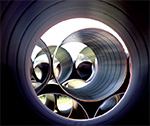The growing demand for gas and the progressive reduction in European production suggest the need for new infrastructure for imports from the areas with the biggest reserves. Greater interconnections between networks in different countries will be necessary in order to make supplies in Europe more secure, from the standpoint of diversifying sources, and to increase integration and market fluidity.
The creation of an integrated gas network is geared toward achieving medium-term objectives, providing for the interconnection of infrastructure, integrated management of storage and regasification capacity with a view to operational balancing and emergency management, the harmonisation of rules of access for use and integrated infrastructure management and coordinated investment planning (especially for cross-border investments).
The opportunities in a dynamic market
Among European regulated utilities, Snam is in an ideal condition for offering itself as aggregator of the planned European network. This is due to the fact that it is bigger than other European players in terms of infrastructure and execution and management capacity, including through partnerships with international operators, and its integrated portfolio of assets in all the regulated segments in the sector (transportation, storage, and regasification), including leadership in the distribution segment.
EUROPEAN GAS MARKET: A SINGLE INTEGRATED NETWORK

Starting from here, Snam thus has before it the challenge and the opportunity of offering itself as the benchmark operator for developing the regulated gas market in Europe, with the prospect of enabling the country to benefit from the advantages deriving from a larger size, access to new supply directives and integration with other European networks.
This opportunity comes from considering two factors:
- Snam’s absolute leadership position in the Italian market, which is a strategic gas hub in the context of the European market;
- the development of the European regulated gas market toward the convergence of regulatory risk profiles, uniform network access rules, and a growing focus on security of supply and diversification of sources.
In the proposed “Regulation on guidelines for trans-European energy infrastructure”, the EU estimates that investment volumes for the 2011-2020 period will increase by 30% in the gas sector compared with current levels. This challenge and urgency in terms of investments clearly distinguishes energy infrastructure from the infrastructure of other sectors, since energy networks are a necessary condition for the achievement of the 2020 energy and climate goals and of more long-term climate goals.
Europe and the energy strategy: the 20–20–20 objectives
In December 2008, the EU adopted an integrated strategy on energy and climate change, which sets ambitious objectives for 2020. The purpose is to put Europe on the right track toward a sustainable future by developing an economy with low CO2 emissions based on energy efficiency. The strategy provides for the following measures:
reducing greenhouse gases by 20% (or by 30%, subject to international agreement);
reducing energy consumption by 20% by increasing energy efficiency;
meeting 20% of our energy needs by using renewable energy.
“Speeding up the restructuring of existing energy infrastructure and developing new infrastructure – writes the European Union in the draft Regulation on guidelines for trans-European energy infrastructure – is of vital importance for achieving political objectives in terms of energy and climate, which consist of completing the internal energy market, ensuring the security of supply, especially for gas and oil, reducing greenhouse gas emissions by 20%, increasing the share of renewable energy in end consumption to 20%, and improving energy efficiency by 20% by 2020. At the same time, the Union must prepare its infrastructure for further decarbonisation of its energy system more over the long term, between now and 2050.”





